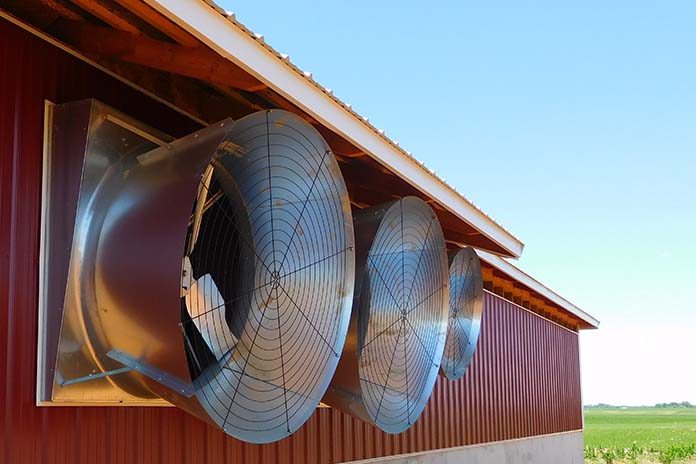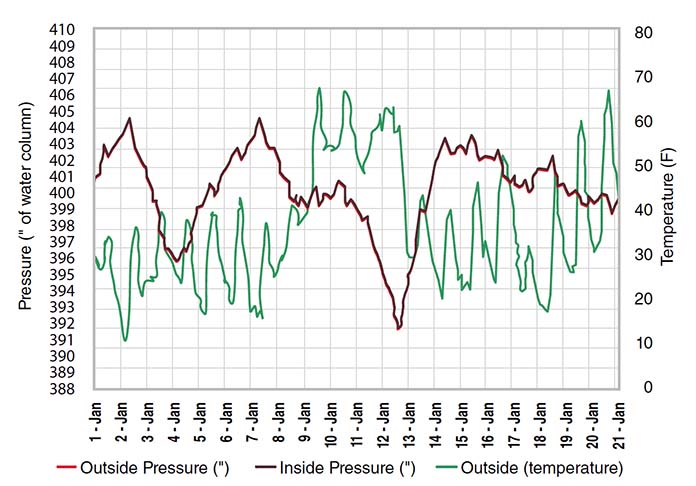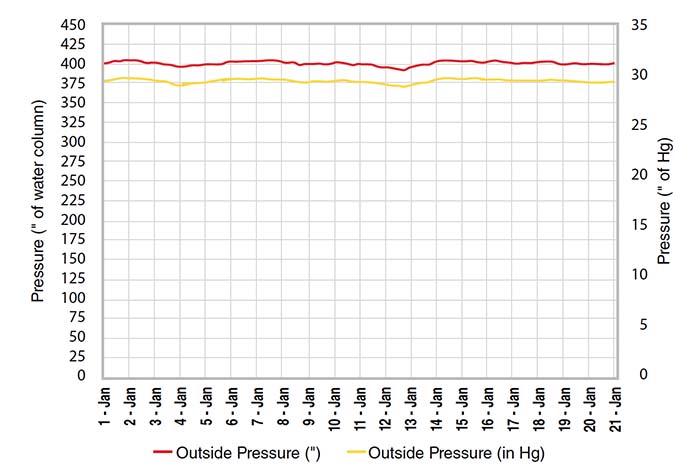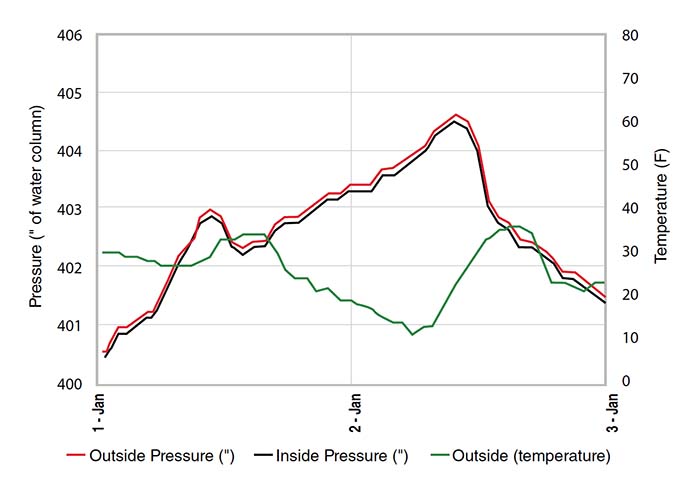
Most poultry are raised in houses that use a negative pressure ventilation systems to aid in maintaining air quality, house temperature, and air movement.
When the exhaust fans operate they create a low-pressure zone within the house and outside air rushes in through either side-wall inlets or tunnel inlets to “fill” the low pressure zone. The higher the level of negative pressure, the lower the air pressure is in the house, the faster outside air rushes in to “fill” the house.
Negative pressure
The negative pressure indicated by a poultry house environmental controller is not an absolute measure of pressure, but rather of the pressure difference between inside and outside a house measured in “inches of water column”. If a controller indicates a negative pressure of 0.10″ this means that the level of low pressure created by the exhaust fans is the same as that required to draw water up a straw 0.10″. The pressure differentials created by the exhaust fans in a poultry house typically run between 0.05″ and 0.20″, but can be as high as 0.25″. Though 0.25″ may seem like a lot of pressure, the fact is that we can easily generate enough negative pressure with our mouths to draw water up a straw more than 36″.
What effect does living in a “low pressure” zone have on the birds?
To answer this question it is important to realize that the level of atmospheric pressure that we and our chickens live in is not constant. As the weather changes from day to day or even hour to hour, so does the atmospheric pressure. As a low-pressure zone, typically associated with stormy weather, moves into an area the atmospheric pressure drops and surface winds move towards the center of the zone of low pressure. Conversely, when a high-pressure zone, typically associated with good, stable weather, moves in to an area the atmospheric pressure rises and surface winds move away from the center of the zone of high pressure.
Atmospheric pressure
Atmospheric pressure is caused essentially by the mass of the atmosphere above us pushing down on us. The lower the altitude, the higher the atmospheric will be. Atmospheric pressure is similar to the water pressure we experience when swimming to the bottom of a pool. The deeper we swim, the greater the pressure exerted upon us by the water above us. Meteorologist typically refer to atmospheric pressure in terms of either inches of mercury (Hg) or bars of pressure. Standard atmospheric pressure, measured at sea level, is 29.92″ Hg, or 1.013 bars. Atmospheric pressure typically ranges between 29″ – 31″ Hg as high and low pressure zones move through of an area. As atmospheric pressure changes outside a house, so does the pressure inside the house. The only difference is that the pressure inside the house will be a little lower than it is outside when the exhaust fans are operating. To understand how much exhaust fans may be affecting the atmospheric pressure the birds are living in, we need to convert the meteorologist pressure measurement of inches of mercury column to the more standard poultry-industry pressure measurement of “inches of water column” by simply multiplying inches of mercury by 13.6 (1″ hg = 13.6″ of water).


Figure 1 illustrates the atmospheric pressure in Athens, Georgia both in terms of inches of mercury and inches of water over three weeks in January 2018. At first glance the atmospheric pressure appears to be very stable, but the normal variations in pressure become more apparent when the graph scale is adjusted to take into account a more typical pressure range of 388″ – 410″ of water (28.5″ hg – 30.1″ Hg) (Figure 2). In Figure 2, “normal” atmospheric pressure often changes an inch or so over the course of a day and sometimes four inches or more. The graph also illustrates what atmospheric pressure would be inside a house if the fans were operating and creating a typical negative pressure of 0.10″, thus lowering the inside atmospheric pressure 0.10″ below that of what it is outside. The difference in pressure between inside and outside the house is very difficult to see because it is extremely small relative to normal atmospheric pressure. Figure 3 is a close-up of the inside and outside atmospheric pressure over January 1 and 2.
Figures 2 and 3 clearly show the magnitude of the difference between changes in pressure caused by changes in the weather relative to those made by the exhaust fans. Specifically, changes in the weather result in atmospheric pressure changes of several inches whereas the exhaust fans are only capable of changing the pressure a tenth of an inch or so. Over the 21-day period typical changes in the pressure inside a poultry house caused by the exhaust fans are less than 1/200th of that brought about by normal changes in weather.

This doesn’t necessarily mean that changes in atmospheric pressure can’t have an affect upon poultry. It is well established that growing birds at high altitudes where the pressure is lower is more difficult due to lower oxygen pressures. But, there is essentially no research that has shown any correlation between normal changes in atmospheric pressure brought about by changes in the weather with bird performance or health. If there were to be a correlation it would be more likely due to the actual changes in the weather associated with atmospheric pressure changes (increased winds, changes in outside temperature, rain, cloud cover, etc.) and not specifically related to the change in atmospheric pressure itself. But then again, even if changes in atmospheric pressure were to have an effect upon the birds, the effect of the pressure caused by the fans is minuscule in comparison and would likely be offset by the benefits associated with the increased level of environment control that negative pressure ventilation affords producers.
The negative pressure created by the exhaust fans it is not really something we have to worry about when it comes to directly affecting bird performance. But, it is important to keep in mind that excessive levels of negative pressure can indirectly adversely affect birds when they are result of poor pad maintenance or improper side-wall/tunnel-inlet operation. Excessive pressure due to dirty pads or insufficient side wall/tunnel opening will reduce the air moving capacity of the exhaust fans, which will reduce air exchange rates and wind speeds. This will in turn will lead to increased house temperatures, reduced air quality and a reduction in our ability to keep our birds cool during hot weather.
















